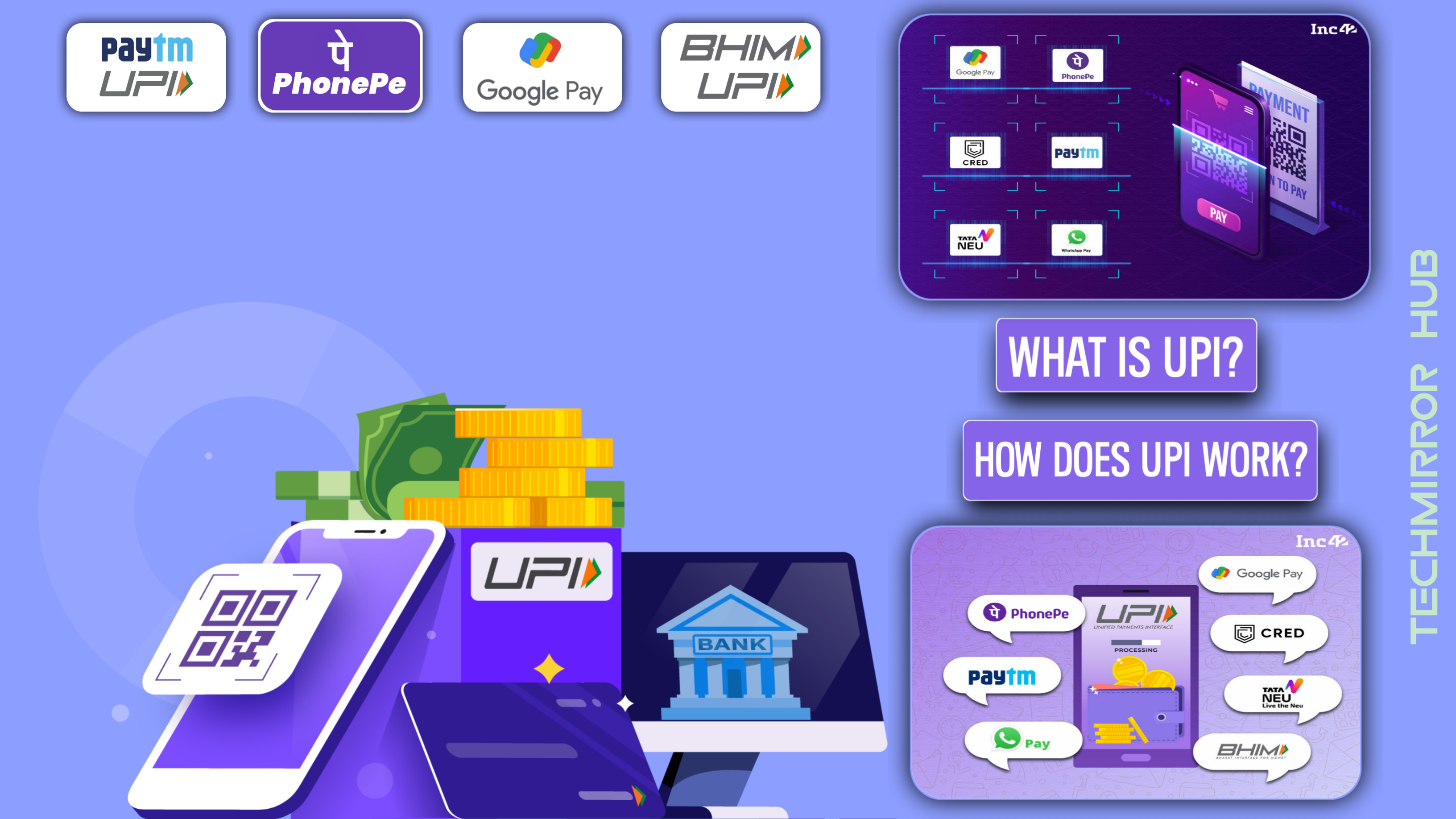Everything You Need to Know About UPI Payments
UPI stands for Unified Payment Interface and is an instant payment system developed by the National Payments Corporation of India (NPCI). The main purpose of UPI is to make financial transactions seamless and convenient for users in India. It allows users to transfer money from one bank account to another bank account instantly and securely using a mobile device.
To use UPI, you will first need to link your bank account with the UPI platform. This can be done through a participating bank’s mobile app or through a third-party app such as Google Pay or PhonePe that support UPI transactions. Once your bank account is linked, you will be assigned a unique UPI ID, which acts as your virtual payment address. This ID can be used to make transactions and receive payments from other UPI users.
To make a transaction, you simply need to enter the recipient’s UPI ID or mobile number and the amount you want to transfer. The recipient will then receive a payment request, which they can approve or reject. Once the payment is approved, the funds are transferred instantly and securely. The best part is that there is no need to remember IFSC codes or account numbers, as the UPI platform takes care of all the details for you.
UPI has revolutionized the way we do digital payments in India, making it easier, faster, and more convenient than ever before. With 24/7 availability and the ability to transfer money to anyone with a bank account, UPI is quickly becoming the go-to solution for digital transactions in India.
I am going to tell you in detail about UPI below, so let’s know…
What is UPI?
Unified Payment Interface UPI is a digital payment system in India that enables instant money transfers between two bank accounts on a mobile platform. This system was introduced by the National Payments Corporation of India (NPCI) to provide a seamless and secure way to transfer money without the need for traditional banking services. With UPI, users can easily link multiple bank accounts, pay bills, and make purchases without sharing their personal banking details. With its user-friendly interface and fast transactions, UPI has become one of the most popular digital payment methods in India and continues to revolutionize the way people handle their finances.
UPI is a system that enables the transfer of money between any two bank accounts in India, through a mobile device. It is built on top of the Immediate Payment Service (IMPS), and allows for real-time, 24/7 transactions. UPI allows for a wide range of transactions, including person-to-person transfers, bill payments, and merchant payments.
How does UPI work?
To use UPI, an individual must first have a bank account with a bank that is a member of the UPI network. They will also need a mobile device with internet access. The individual can then download a UPI app from their bank or from a third-party app store.
Once the app is downloaded, the individual will have to link their bank account to the app by entering their account number, IFSC code, and other required details. They will also have to create a UPI ID, which is a unique identifier for their account. This ID can be in the form of an email address or a mobile number.
After linking their bank account, the individual can now make transactions through the app. To make a transfer, they will have to enter the recipient’s UPI ID or account number, and the amount they wish to transfer. The transaction will then be processed in real-time, and the funds will be credited to the recipient’s account.
How is UPI different from all those apps? I want to tell you this by giving an example.
UPI (Unified Payment Interface) is different from other digital payment apps in several ways. One major difference is that UPI enables users to directly transfer money from one bank account to another, without the need for a wallet or a separate digital account.
For example, consider a person who wants to transfer money to their friend using a digital payment app. In most cases, they would need to first transfer the money to their digital wallet and then send it to their friend’s wallet. This can be time-consuming and may also incur additional charges.
With UPI, however, the process is much simpler. The person can directly transfer money from their bank account to their friend’s bank account using their mobile phone. This eliminates the need for a digital wallet and enables faster and more convenient transactions.
Another difference between UPI and other digital payment apps is that UPI is not limited to peer-to-peer transfers. Users can also use UPI to pay bills, make purchases, and even check their bank account balance. This makes UPI a comprehensive digital payment solution for users in India.
What is UPI ID:
UPI ID (Unified Payment Interface ID) is a virtual payment address that is linked to a user’s bank account. It is a unique identifier that enables users to make and receive payments via UPI (Unified Payment Interface). The UPI ID acts as an email ID for bank transactions, allowing users to send and receive money without having to remember their bank account number or IFSC code.
A UPI ID consists of a combination of letters and numbers, and is typically in the format of [Name or Nickname]@[Bank Name]. For example, a UPI ID could look like JohnDoe@ICICI or JaneSmith@HDFC.
To create a UPI ID, users need to have a bank account with a participating bank and download a UPI-enabled mobile app, such as BHIM,Paytm,Phone-pe or Google Pay. They can then link their bank account with the UPI ID and start using the service to make and receive payments.
I am going to tell you in detail about how to create upi id in these 4 apps (Paytm,Phone-pe,BHIM or Google Pay) :
1. How to create UPI ID in Paytm APP 📱
To create a UPI ID in Paytm, you need to follow these steps ✅ :
- Download the Paytm app and sign up for an account if you haven’t already.
- Once you’re logged in, tap on the “Bank” option on the home screen.
- Next, select the “UPI” option and then tap on the “Create a UPI ID” button.
- Enter your name, bank account number and IFSC code, and choose a UPI ID.
- Verify your bank account with the help of a One-Time Password (OTP) sent to your registered mobile number.
- Once your UPI ID is created, you can use it to make payments directly from your Paytm app to other UPI enabled bank accounts.
Note: Before you start, make sure your bank account is linked to your mobile number, as UPI requires this information for authentication.
2. How to create UPI ID in Phone-pe APP 📱
To create a UPI ID in PhonePe, follow these steps ✅:
- Download and install the PhonePe app from the App Store or Google Play Store.
- Sign up for a PhonePe account and log in.
- On the home screen, tap on the “Bank Accounts” option.
- Tap on the “Create UPI ID” button.
- Enter your name, mobile number and select the bank account you want to link to your UPI ID.
- Verify your mobile number with an OTP (One Time Password) sent to your registered mobile number.
- Choose a unique UPI ID, which can be a combination of your name and numbers.
- Verify your bank account details and set a UPI PIN.
- Once your UPI ID is created, you can use it to make payments, check bank balance, view transaction history and more.
Note: Make sure your mobile number is linked to your bank account, as it is mandatory for UPI transactions.
3. How to create UPI ID in Google Pay app 📱
To create a UPI ID in the Google Pay app, follow these steps ✅ :
- Download and install the Google Pay app from the Google Play Store.
- Open the app and sign in with your Google account.
- Tap on your profile icon in the top-right corner.
- Select the Bank account option.
- Tap on ‘Add Bank Account’ and select the bank that you hold an account with.
- Enter the required details like your bank account number and IFSC code.
- Google Pay will verify your bank account details, and once it’s successful, you will be able to create your UPI ID.
- To create your UPI ID, tap on ‘Create UPI ID’ and enter a unique ID of your choice.
- Verify your mobile number via an SMS OTP and set a UPI PIN.
- Your UPI ID is now created, and you can use it for transactions via Google Pay.
Note: Your UPI ID must be unique and can be created only once.
4. How to create UPI ID in BHIM APP 📱
Here are the steps to create a UPI ID in the BHIM (Bharat Interface for Money) app ✅:
- Download and install the BHIM app from the Google Play Store.
- Open the app and select your preferred language.
- Enter your mobile number and verify it with a one-time password (OTP).
- Choose a bank from the list of UPI-enabled banks and link it to the app.
- Set a 4-digit passcode to secure your UPI transactions.
- Enter your personal details such as your name, email address, and complete the setup process.
- To create your UPI ID, tap on the “Create UPI ID” option from the menu and enter the desired UPI ID. It should be in the format of “yourName@bankName“.
- Verify your UPI ID by entering the last 6 digits of your linked bank account number and the expiry date of your linked debit card.
- After the verification process is complete, your UPI ID will be created and you can start using it for transactions.
Note: The process may slightly vary based on the latest app updates and your specific device.
Benefits of UPI
- Convenience: UPI allows for quick and easy transactions through a mobile device, without the need for cash or cheques.
- Safety: UPI transactions are secure, as they require a one-time password (OTP) or biometric authentication to be completed.
- Wide reach: UPI is accepted by a large number of banks and merchants in India, making it accessible to a wide range of users.
- Low costs: UPI transactions are relatively low-cost, as they do not require any additional charges.
Limitations of UPI
- Limited to India: UPI can only be used for transactions within India.
- Requires internet: UPI transactions require an internet connection to be completed.
- Limited transaction amount: UPI transactions are limited to a maximum of Rs 2 Lakhs per transaction
- Limited merchant acceptance: UPI is still in early stages and not all merchants accept it.
Conclusion UPI is a revolutionary payment system that allows for instant, secure transactions between bank accounts in India through a mobile device. It has a wide range of benefits, including convenience, safety, and low costs. However, it does have some limitations, such as being limited to India and requiring an internet connection. Despite these limitations, UPI has the potential to greatly increase financial inclusion in India and make transactions easier for millions of people.
What is the full form of UPI : Unified Payment Interface
UPI (Unified Payment Interface) is supported by numerous banks in India. Some of the major UPI enabled banks are:
- State Bank of India (SBI)
- HDFC Bank
- ICICI Bank
- Axis Bank
- Bank of Baroda (BOB)
- Canara Bank
- Union Bank of India
- Bank of India
- Punjab National Bank (PNB)
- Central Bank of India
- IDBI Bank
- Kotak Mahindra Bank
- Federal Bank
- IndusInd Bank
- Vijaya Bank
This list is not exhaustive and there may be other banks that support UPI as well. It’s always best to check with your bank to confirm if they support UPI.
FAQs About UPI:
- What is UPI? UPI stands for Unified Payments Interface. It is a real-time payment system that enables the transfer of money between any two bank accounts in India through a mobile device.
- How does UPI work? To use UPI, an individual must first have a bank account with a bank that is a member of the UPI network. They will also need a mobile device with internet access. The individual can then download a UPI app from their bank or from a third-party app store. They canlink their bank account to the app by entering their account number, IFSC code, and other required details, and create a unique UPI ID. To make a transaction, the individual simply enters the recipient’s UPI ID or account number, and the amount they wish to transfer, and the transaction is processed in real-time.
- What are the benefits of using UPI? UPI offers convenience, safety, wide reach, and low costs. Transactions can be made quickly and easily through a mobile device, without the need for cash or cheques. Transactions are secure, requiring a one-time password or biometric authentication, and UPI is accepted by a large number of banks and merchants in India. Additionally, UPI transactions have relatively low costs, without additional charges.
- What are the limitations of using UPI? UPI is currently limited to India, and transactions require an internet connection. There is also a limit of Rs 2 Lakhs per transaction, and not all merchants currently accept UPI.
- How do I link my bank account to UPI? To link your bank account to UPI, you will first need to download a UPI app from your bank or a third-party app store. Once the app is downloaded, you will have to enter your account number, IFSC code, and other required details, and create a unique UPI ID. Your bank account will then be linked and ready to use for UPI transactions.
- Can I use UPI for international transactions? No, UPI is currently limited to transactions within India.
- Is UPI a safe and secure payment method? Yes, UPI transactions are secure, as they require a one-time password or biometric authentication to be completed. Additionally, UPI transactions are processed in real-time, which reduces the risk of fraud.
- Can I use UPI for all types of transactions? Yes, UPI allows for a wide range of transactions, including person-to-person transfers, bill payments, and merchant payments.
- Are there any additional charges for using UPI? No, UPI transactions have relatively low costs and do not require any additional charges.
- How can I find a UPI app to download? UPI apps can be downloaded from your bank’s website or from a third-party app store such as Google Play Store or Apple App Store. It’s also available on various banking apps like SBI, ICICI, HDFC etc.





ANIMAL
Hlo